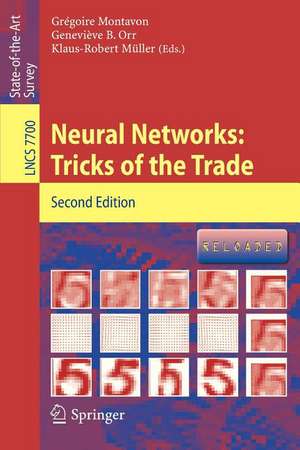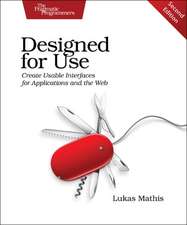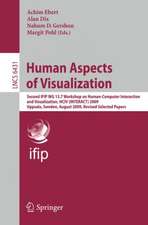Neural Networks: Tricks of the Trade: Lecture Notes in Computer Science, cartea 7700
Editat de Grégoire Montavon, Geneviève Orr, Klaus-Robert Mülleren Limba Engleză Paperback – 6 noi 2012
The second edition of the book augments the first edition with more tricks, which have resulted from 14 years of theory and experimentation by some of the world's most prominent neural network researchers. These tricks can make a substantial difference (in terms of speed, ease of implementation, and accuracy) when it comes to putting algorithms to work on real problems.
Din seria Lecture Notes in Computer Science
- 20%
 Preț: 1061.55 lei
Preț: 1061.55 lei - 20%
 Preț: 307.71 lei
Preț: 307.71 lei - 20%
 Preț: 438.69 lei
Preț: 438.69 lei - 20%
 Preț: 645.28 lei
Preț: 645.28 lei -
 Preț: 410.88 lei
Preț: 410.88 lei - 15%
 Preț: 580.46 lei
Preț: 580.46 lei - 17%
 Preț: 427.22 lei
Preț: 427.22 lei - 20%
 Preț: 596.46 lei
Preț: 596.46 lei -
 Preț: 449.57 lei
Preț: 449.57 lei - 20%
 Preț: 353.50 lei
Preț: 353.50 lei - 20%
 Preț: 1414.79 lei
Preț: 1414.79 lei - 20%
 Preț: 309.90 lei
Preț: 309.90 lei - 20%
 Preț: 583.40 lei
Preț: 583.40 lei - 20%
 Preț: 1075.26 lei
Preț: 1075.26 lei - 20%
 Preț: 310.26 lei
Preț: 310.26 lei - 20%
 Preț: 655.02 lei
Preț: 655.02 lei - 20%
 Preț: 580.93 lei
Preț: 580.93 lei - 20%
 Preț: 340.32 lei
Preț: 340.32 lei - 18%
 Preț: 938.83 lei
Preț: 938.83 lei - 20%
 Preț: 591.51 lei
Preț: 591.51 lei - 15%
 Preț: 438.59 lei
Preț: 438.59 lei - 20%
 Preț: 337.00 lei
Preț: 337.00 lei -
 Preț: 389.48 lei
Preț: 389.48 lei - 20%
 Preț: 607.39 lei
Preț: 607.39 lei - 20%
 Preț: 1024.44 lei
Preț: 1024.44 lei - 20%
 Preț: 579.30 lei
Preț: 579.30 lei - 20%
 Preț: 763.23 lei
Preț: 763.23 lei - 20%
 Preț: 453.32 lei
Preț: 453.32 lei - 20%
 Preț: 575.48 lei
Preț: 575.48 lei - 20%
 Preț: 585.88 lei
Preț: 585.88 lei - 20%
 Preț: 825.93 lei
Preț: 825.93 lei - 20%
 Preț: 763.23 lei
Preț: 763.23 lei - 17%
 Preț: 360.19 lei
Preț: 360.19 lei - 20%
 Preț: 1183.14 lei
Preț: 1183.14 lei - 20%
 Preț: 340.32 lei
Preț: 340.32 lei - 20%
 Preț: 504.57 lei
Preț: 504.57 lei - 20%
 Preț: 369.12 lei
Preț: 369.12 lei - 20%
 Preț: 583.40 lei
Preț: 583.40 lei - 20%
 Preț: 343.62 lei
Preț: 343.62 lei - 20%
 Preț: 350.21 lei
Preț: 350.21 lei - 20%
 Preț: 764.89 lei
Preț: 764.89 lei - 20%
 Preț: 583.40 lei
Preț: 583.40 lei - 20%
 Preț: 649.49 lei
Preț: 649.49 lei - 20%
 Preț: 341.95 lei
Preț: 341.95 lei - 20%
 Preț: 238.01 lei
Preț: 238.01 lei - 20%
 Preț: 538.29 lei
Preț: 538.29 lei
Preț: 891.62 lei
Preț vechi: 1114.52 lei
-20% Nou
Puncte Express: 1337
Preț estimativ în valută:
170.61€ • 178.13$ • 141.20£
170.61€ • 178.13$ • 141.20£
Carte tipărită la comandă
Livrare economică 05-19 aprilie
Preluare comenzi: 021 569.72.76
Specificații
ISBN-13: 9783642352881
ISBN-10: 364235288X
Pagini: 784
Ilustrații: XII, 769 p. 223 illus.
Dimensiuni: 155 x 235 x 41 mm
Greutate: 1.08 kg
Ediția:2nd ed. 2012
Editura: Springer Berlin, Heidelberg
Colecția Springer
Seriile Lecture Notes in Computer Science, Theoretical Computer Science and General Issues
Locul publicării:Berlin, Heidelberg, Germany
ISBN-10: 364235288X
Pagini: 784
Ilustrații: XII, 769 p. 223 illus.
Dimensiuni: 155 x 235 x 41 mm
Greutate: 1.08 kg
Ediția:2nd ed. 2012
Editura: Springer Berlin, Heidelberg
Colecția Springer
Seriile Lecture Notes in Computer Science, Theoretical Computer Science and General Issues
Locul publicării:Berlin, Heidelberg, Germany
Public țintă
ResearchCuprins
Introduction.- Preface on Speeding Learning.- 1. Efficient BackProp.- Preface on Regularization Techniques to Improve Generalization.- 2. Early Stopping — But When?.- 3. A Simple Trick for Estimating the Weight Decay Parameter.- 4. Controlling the Hyperparameter Search in MacKay’s Bayesian Neural Network Framework.- 5. Adaptive Regularization in Neural Network Modeling.- 6. Large Ensemble Averaging.- Preface on Improving Network Models and Algorithmic Tricks.- 7. Square Unit Augmented, Radially Extended, Multilayer Perceptrons.- 8. A Dozen Tricks with Multitask Learning.- 9. Solving the Ill-Conditioning in Neural Network Learning.- 10. Centering Neural Network Gradient Factors.- 11. Avoiding Roundoff Error in Backpropagating Derivatives.- 12. Transformation Invariance in Pattern Recognition –Tangent Distance and Tangent Propagation.- 13. Combining Neural Networks and Context-Driven Search for On-line, Printed Handwriting Recognition in the Newtons.- 14. Neural Network Classification and Prior Class Probabilities.- 15. Applying Divide and Conquer to Large Scale Pattern Recognition Tasks.- Preface on Tricks for Time Series.- 16. Forecasting the Economy with Neural Nets: A Survey of Challenges and Solutions.- 17. How to Train Neural Networks.- Preface on Big Learning in Deep Neural Networks.- 18. Stochastic Gradient Descent Tricks.- 19. Practical Recommendations for Gradient-Based Training of Deep Architectures.- 20. Training Deep and Recurrent Networks with Hessian-Free Optimization.- 21. Implementing Neural Networks Efficiently.- Preface onBetter Representations: Invariant, Disentangled and Reusable.- 22. Learning Feature Representations with K-Means.- 23. Deep Big Multilayer Perceptrons for Digit Recognition.- 24. A Practical Guide to Training Restricted Boltzmann Machines.- 25. Deep Boltzmann Machines and the Centering Trick.- 26. Deep Learning via Semi-supervised Embedding.- Preface on Identifying Dynamical Systems for Forecasting and Control.- 27. A Practical Guide to Applying Echo State Networks.- 28. Forecasting with Recurrent Neural Networks: 12 Tricks.- 29. Solving Partially Observable Reinforcement Learning Problems with Recurrent Neural Networks.- 30. 10 Steps and Some Tricks to Set up Neural Reinforcement Controllers.
Textul de pe ultima copertă
The twenty last years have been marked by an increase in available data and computing power. In parallel to this trend, the focus of neural network research and the practice of training neural networks has undergone a number of important changes, for example, use of deep learning machines.
The second edition of the book augments the first edition with more tricks, which have resulted from 14 years of theory and experimentation by some of the world's most prominent neural network researchers. These tricks can make a substantial difference (in terms of speed, ease of implementation, and accuracy) when it comes to putting algorithms to work on real problems.
The second edition of the book augments the first edition with more tricks, which have resulted from 14 years of theory and experimentation by some of the world's most prominent neural network researchers. These tricks can make a substantial difference (in terms of speed, ease of implementation, and accuracy) when it comes to putting algorithms to work on real problems.
Caracteristici
The second edition of the book "reloads" the first edition with more tricks Provides a timely snapshot of tricks, theory and algorithms that are of use














